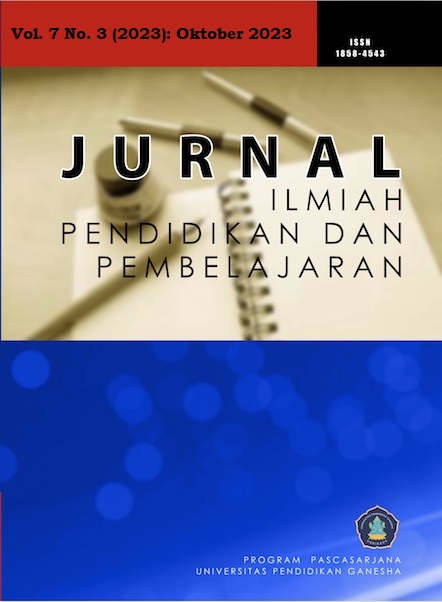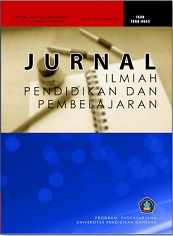Game Based Learning Design and Development for Effective Instructional Process at Senior High School Level
DOI:
https://doi.org/10.23887/jipp.v7i3.58391Keywords:
multimedia, game based learning, grammarAbstract
Information and Communication Technology (ICT) helps people learn is becoming more and more common in the teaching process. This lets learners keep learning by using their mobile devices to access their learning tools. On the other hand, language teachers, who are often both users and creators of teaching and learning activities, do not always know how to use and apply the steps on designing the lesson by infiltrating technology. The purpose of this study is to develop the efficacy of game-based learning multimedia in enhancing student-learning outcomes in the classroom with regard to English grammar. The research development of multimedia game-based learning using the Raiser and Demsey procedure. The trial of product development had passed multiple processes, including: the review from a media expert, which included software changes and visual communication; the review from a content expert, which included material and instructional design; the responses of students to the product's usability and attractiveness; and the review from a content expert. The implication of this study is that the language learning design with the ICT approach is able to fulfil the needs and skills of students. Gamification can enhance the learning process because it can engage and motivate students with games.
References
Alrwele, D. N. S. (2017). Effects of Infographics on Student Achievement and Students’ Perceptions of the Impacts of Infographics. Journal of Education and Human Development, 6(3), 104–117. https://doi.org/10.15640/jehd.v6n3a12.
Fatimah, A. S., & Santiana, S. (2017). Teaching in 21St Century: Students-Teachers’ Perceptions of Technology Use in the Classroom. Script Journal: Journal of Linguistic and English Teaching, 2(2), 125. https://doi.org/10.24903/sj.v2i2.132.
Greipl, S., Klein, E., Lindstedt, A., Kiili, K., Moeller, K., Karnath, H., Bloechle, J., Ninaus, M., Greipl, S., Klein, E., Lindstedt, A., Kiili, K., & Moeller, K. (2021). When the brain comes into play : Neurofunctional correlates of emotions and reward in game-based learning To cite this version : HAL Id : halshs-03344056 Computers in Human Behavior and reward in game-based learning. Computers in Human Behavior, 125, 106946. https://doi.org/10.1016/j.chb.2021.106946.
Hamidi, N. (2018). Pengembangan Media Pembelajaran Interaktif Pendidikan Agama Islam Berbasis Adobe Flash Professional Cs6 Untuk Mendukung Implementasi Kurikulum 2013. Jurnal Pendidikan Agama Islam, 14(1), 109–130. https://doi.org/10.14421/jpai.2017.141-07.
Hattie, J., Hodis, F. A., & Kang, S. H. K. (2020). Theories of motivation: Integration and ways forward. Contemporary Educational Psychology. Contemporary Educational Psychology, 61, 101865. https://doi.org/10.1016/j.cedpsych.2020.101865.
Hidi, S., & Renninger, K. A. (2006). The Four-Phase Model of Interest Development. Educational and Psychologist, 41(2), 111–127. https://doi.org/10.1207/s15326985ep4102_4
Howard, J. L., Bureau, J., Guay, F., Chong, J. X. Y., & Ryan, R. M. (2021). Student motivation and associated outcomes: A meta-analysis from self-determination theory. Perspectives on Psychological Science, 16(6), 1300–1323. https://doi.org/10.1177/1745691620966789.
Hui, C., Ho, C., & Lin, J. (2015). The development of an augmented reality game-based learning environment. Procedia - Social and Behavioral Sciences, 174, 216–220. https://doi.org/10.1016/j.sbspro.2015.01.649.
Hurtado, C. M., Madariaga, L., Nussbaum, M., Heller, R., Bennett, S., Tsai, C., & Braak, J. Van. (2019). Editorial: Educational technology and addictions. Computers & Education, 103730. https://doi.org/10.1016/j.compedu.2019.103730.
Kiili, K., Lainema, T., Freitas, S. De, & Arnab, S. (2014). Flow framework for analyzing the quality of educational games q. Entertainment Computing, 5(4), 367–377. https://doi.org/10.1016/j.entcom.2014.08.002.
Kiili, K., Lindstedt, A., Koskinen, A., & Halme, H. (2021). Flow Experience and Situational Interest in Game-Based Learning : Cousins or Identical Twins. International Journal of Serious Games, 8(3), 93–114. https://doi.org/10.17083/ijsg.v8i3.462.
Koskinen, A., Mcmullen, J., Ninaus, M., & Kiili, K. (2023). Does the emotional design of scaffolds enhance learning and motivational outcomes in game-based learning ? Journal of Computer Assisted Learning, 39(1), 77–93. https://doi.org/10.1111/jcal.12728.
Kraft, M. A. (2020). Interpreting Effect Sizes of Education Interventions. Educational Researcher, 499(4), 241–253. https://doi.org/10.3102/0013189X20912798.
Krapp, A. (2017). An educational – psychological conceptualisation of interest An educational-psychological conceptualisation of interest. International Journal for Educational and Vocational Guidance, 7, 5–21. https://doi.org/10.1007/s10775-007-9113-9.
Kriegbaum, K., Becker, N., Spinath, B., & Becker, N. (2018). Author Note. Educational Research Review. https://doi.org/10.1016/j.edurev.2018.10.001.
Liu, Z., Moon, J., Kim, B., & Pu, C. (2020). Integrating adaptivity in educational games : a combined bibliometric analysis and meta ‑ analysis review. Educational Technology Research and Development, 0123456789. https://doi.org/10.1007/s11423-020-09791-4.
Mayer, R. E. (2013). Incorporating motivation into multimedia learning. Learning and Instruction, 3–5. https://doi.org/10.1016/j.learninstruc.2013.04.003.
Miarso, Y. H. (2009). Menyemai Benih Teknologi Pendidikan. Kencana Prenada Media Group.
Mills, C., Mello, S. D., Lehman, B., Bosch, N., Strain, A., & Graesser, A. (2013). What Makes Learning Fun ? Exploring the Influence of Choice and Difficulty on Mind Wandering and Engagement during Learning. In Artificial Intelligence in Education: 16th International Conference, 71–72. https://link.springer.com/chapter/10.1007/978-3-642-39112-5_8.
Ninaus, M., Kiili, K., Mcmullen, J., & Moeller, K. (2017). Computers in Human Behavior Assessing fraction knowledge by a digital game. Computers in Human Behavior, 70, 197–206. https://doi.org/10.1016/j.chb.2017.01.004.
Ninaus, M., & Nebel, S. (2021). A Systematic Literature Review of Analytics for Adaptivity Within Educational Video Games. In Frontiers in Education, 5(January). https://doi.org/10.3389/feduc.2020.611072.
Ningrum, A. S., Muslim, S., & Siregar, E. (2021). Multimedia Simulation Model on Basic Electricial and Electronics Subjects for Vocational Secondary School. Journal of Educational Research and Evaluation, 6(1), 72–79. https://doi.org/10.23887/jere.v6i1.38783.
Oostendorp, H. Van, Spek, E. D. Van Der, & Linssen, J. (2014). Adapting the Complexity Level of a Serious Game to the Proficiency of Players. EAI Endorsed Transactions on Serious Games, 1(2), 1–8. https://doi.org/10.4108/sg.1.2.e5.
Orvis, K. A., Horn, D. B., & Belanich, J. (2008). The roles of task difficulty and prior videogame experience on performance and motivation in instructional videogames. Computers in Human Behavior, 24, 2415–2433. https://doi.org/10.1016/j.chb.2008.02.016.
Ozdamli, F., & Ozdal, H. (2018). Developing an instructional design for the design of infographics and the evaluation of infographic usage in teaching based on teacher and student opinions. Eurasia Journal of Mathematics, Science and Technology Education, 14(4), 1197–1219. https://doi.org/10.29333/ejmste/81868.
Papadakis, S. (2020). Evaluating a game-development approach to teach introductory programming concepts in secondary education. International Journal of Technology Enhanced Learning, 12(2), 127–145,. https://doi.org/10.1504/ijtel.2020.106282.
Plass, J. L., Homer, B. D., & Kinzer, C. K. (2015). Foundations of Game-Based Learning. Educational Psychologist, 50(4), 258–283. https://doi.org/10.1080/00461520.2015.1122533.
Plass, J. L., & Pawar, S. (2020). Toward a taxonomy of adaptivity for learning. Journal of Research on Technology in Education, 52(3), 275–300. https://doi.org/10.1080/15391523.2020.1719943
Putra, N. (2012). Metode penelitian kualitatif pendidikan. Rajawali Pers.
Raiser, R.A & Dempsey, J. V. (2007). Trends and Issues in Instructional Design and Technology. Pearson Merril Prentice Hall.
Renninger, K. A., Bachrach, J. E., & Hidi, S. E. (2019). Learning , Culture and Social Interaction Triggering and maintaining interest in early phases of interest. Learning, Culture and Social Interaction, 23(December 2018), 100260. https://doi.org/10.1016/j.lcsi.2018.11.007.
Ronimus, M., Kujala, J., Tolvanen, A., & Lyytinen, H. (2014). Computers & Education Children ’ s engagement during digital game-based learning of reading : The effects of time , rewards , and challenge. Computers & Education, 71, 237–246. https://doi.org/10.1016/j.compedu.2013.10.008.
Ryan, R. M., & Deci, E. L. (2020). Intrinsic and extrinsic motivation from a self-determination theory perspective: Definitions, theory, practices, and future directions. Contemporary Educational Psychology, 61, 101860. https://doi.org/10.1016/j.cedpsych.2020.101860.
Ryan, R. M., Rigby, C. S., & Przybylski, A. (2006). The Motivational Pull of Video Games : A Self-Determination Theory Approach. Motiv Emot, 30, 347–363. https://doi.org/10.1007/s11031-006-9051-8.
Sajjadi, P. (2022). Individualization in serious games: a systematic review of the literature on the aspects of the players to adapt to. Entertainment Computing, 41, 100468. https://doi.org/10.1016/j.entcom.2021.100468.
Sampayo-vargas, S., Cope, C. J., He, Z., & Byrne, G. J. (2013). Computers & Education The effectiveness of adaptive dif fi culty adjustments on students ’ motivation and learning in an educational computer game. Computers & Education, 69, 452–462. https://doi.org/10.1016/j.compedu.2013.07.004.
Shute, V., Smith, G., & Kuba, C. D. R. (2020). Maximizing learning without sacrificing the fun: Stealth assessment, adaptivity and learning supports in educational games. Journal of Computer Assisted Learning, 37(1), 127–141. https://doi.org/10.1111/jcal.12473.
Susilana, R., & Riyana, C. (2009). Media Pembelajaran. CV Wacana Prima.
Syafriatma, W., & Amini, R. (2021). Pengembangan Bahan Ajar Tematik Terpadu Berbasis Value Clarification Technique (VCT) Example di Kelas V SD. Jurnal Pendidikan Tambusai, 5, 1127–1133. https://jurnal.unimed.ac.id/2012/index.php/handayani/article/view/34172.
Tapola, A., Veermans, M., & Niemivirta, M. (2013). Predictors and outcomes of situational interest during a science learning task. Instructional Science, 41, 1047–1064. https://doi.org/10.1007/s11251-013-9273-6.
Tian, J., Bartek, V., Rahman, M. Z., & Gunderson, E. A. (2021). Learning Improper Fractions with the Number Line and the Area Model Learning Improper Fractions with the Number Line and the. Journal of Cognition and Development, 22(2), 305–327. https://doi.org/10.1080/15248372.2021.1890603.
Vanbecelaere, S., Berghe, K. Van Den, Cornillie, F., Sasanguie, D., Reynvoet, B., & Depaepe, F. (2019). The effectiveness of adaptive versus non‐adaptive learning with digital educational games. Journal of Computer Assisted Learning, 36(4), 502-513. https://doi.org/10.1111/jcal.12416.
Wigfield, A., & Koenka, A. C. (2020). Where do we go from here in academic motivation theory and research ? Some reflections and recommendations for future work. Contemporary Educational Psychology, 101872. https://doi.org/10.1016/j.cedpsych.2020.101872.
Wilson, R. C., Shenhav, A., Straccia, M., & Cohen, J. D. (2019). The Eighty Five Percent Rule for optimal learning. Nature Communications, 10(1), 1–9. https://doi.org/10.1038/s41467-019-12552-4.
Zhang, K., & Begum, A. (2021). Computers and Education : Artificial Intelligence AI technologies for education : Recent research & future directions. Computers and Education: Artificial Intelligence, 2, 100025. https://doi.org/10.1016/j.caeai.2021.100025.
Downloads
Published
How to Cite
Issue
Section
License
Copyright (c) 2023 Budi Setiawan

This work is licensed under a Creative Commons Attribution-ShareAlike 4.0 International License.
Authors who publish with the Jurnal Ilmiah Pendidikan dan Pembelajaran (JIPP) agree to the following terms:
- Authors retain copyright and grant the journal the right of first publication with the work simultaneously licensed under a Creative Commons Attribution License (CC BY-SA 4.0) that allows others to share the work with an acknowledgment of the work's authorship and initial publication in this journal.
- Authors are able to enter into separate, additional contractual arrangements for the non-exclusive distribution of the journal's published version of the work (e.g., post it to an institutional repository or publish it in a book), with an acknowledgment of its initial publication in this journal.
- Authors are permitted and encouraged to post their work online (e.g., in institutional repositories or on their website) prior to and during the submission process, as it can lead to productive exchanges, as well as earlier and greater citation of published work. (See The Effect of Open Access)










